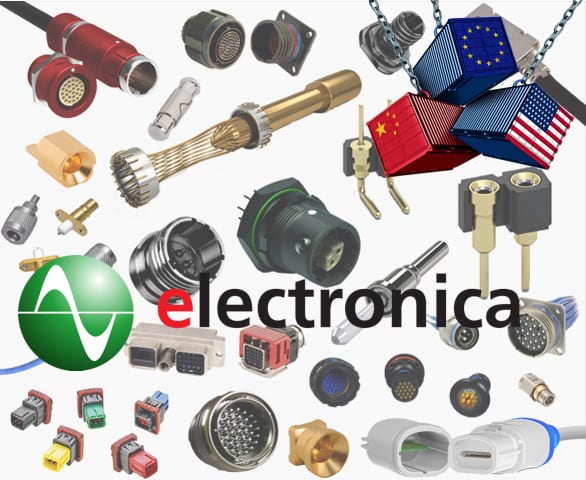Strong Connector Sales in 2018 and a Possible Forecast for 2019
Bishop & Associates visited with connector company CEOs at electronica 2018. Sales this year have been largely very good, but the connector industry forecast for 2019 remains unclear.
 Most connector manufacturers at the electronica 2018 trade fair, which took place November 13–16 in Munich, were able to look back upon a very successful 2018, as this year has turned out to be the second consecutive year with double-digit growth for the global connector market. After 11.0% growth in 2017, Bishop & Associates estimates that 2018 will close with 11.2% growth over 2017. But what does the connector industry forecast for 2019? It remains to be seen.
Most connector manufacturers at the electronica 2018 trade fair, which took place November 13–16 in Munich, were able to look back upon a very successful 2018, as this year has turned out to be the second consecutive year with double-digit growth for the global connector market. After 11.0% growth in 2017, Bishop & Associates estimates that 2018 will close with 11.2% growth over 2017. But what does the connector industry forecast for 2019? It remains to be seen.
Such high growth rates over a short time period do have downsides, however. Some companies grew by 20+ percentage points, and rapid expansion can put strains on an organization, its supply chain, and production capacity.
Was 2018 a good year across the board? Not entirely. Some clouds have gathered over the automotive market. This sector has slowed down around the world due to a number of factors. In Europe, new emission testing regulations brought a surge of sales earlier in the year, followed by a slowdown. In the US, tariffs on aluminum, steel, and electronic components hit a sector already moving into a cyclical downturn. (A week after electronica, US automaker GM announced mass layoffs and plant closures in the US and Canada, as it restructured to send those jobs to China and Mexico.) In addition to the ongoing uncertainty surrounding the trade war between China and the US, tense Brexit negotiations played in the background of the show. Events impacting the automotive sector can cause a ripple effect in other markets, such as industrial robots, as well, so the electronics industry is likely to see trouble ahead in many auto-related areas.
During the show, the news also came in that the German economy had contracted in the third quarter of 2018, the first contraction the country has seen since 2015. This contraction is attributed to the slowdown in the German automotive market and to lower exports as a result of uncertainties in international markets. Germany, the motor of the European economy, is an important bellwether for the wider EU economy, and growth in the EU has effectively softened.
In the US, the highly anticipated November midterm elections resulted in a shift in legislative powers. Yet, how this will influence the agenda of the Trump administration over the coming two years remains to be seen. The economy is strong and unemployment is at a record low. However, divergence between monetary policies in the US, Europe, and other regions makes the US dollar stronger, and that may eventually start to hurt US exports. US wage rises, which hit a nine-year high, could have a similar effect, but the impact of these rises is tempered by higher inflation.
As far as the raw material markets are concerned, crude oil prices rose in 2018 — until the third quarter. From October onward, crude oil prices have nosedived. Prices of raw materials tracked by Bishop & Associates, including copper, gold, steel, and plastics, increased by an average of 8.9% in the first half of 2018.
Lead Times
Feedback from connector makers at the show provided us with a mixed picture. Various companies reported increasing lead times for selected products. Other companies did not think lead times were a big issue. Lead times are coming down slightly, with bookings softening in the third quarter. In general, it appears that for selected product/market combinations, lead times increased due to raw materials availability and lack of production capacity.
Raw Materials: Pricing and Availability
Overall, connector manufacturers at the show said they are not greatly affected by raw material prices and availability, but there were certainly exceptions. Some manufacturers struggled with very specific issues.
So far, gold has not gone up excessively. In addition, gold prices are often covered by a “gold clause” in large blanket contracts. If stock markets remain volatile and in negative territory, however, we may see gold prices rise. Palladium prices, on the other hand, have soared. Palladium nickel is used in the connector industry as an alternative for gold and it is used in automotive catalytic converters to process polluting gases into less harmful gases.
Problems accessing specific copper alloys (e.g., beryllium copper) and plastics were mentioned by several manufactures. Rising oil prices in the beginning of the year led to higher prices for plastics. In some countries, new legislation that regulates plastics production and waste also affects this industry. Issues surrounding plastics appeared to affect the connector industry more than those involving other raw materials.
Problems at Baoshida SwissMetal, which announced an “adjournment of bankruptcy until mid-April 2019” in October, also had an impact, particularly on European companies. Bringing in new raw material suppliers is not always easy, and they are not abundant. As demand is still high, they may also quote high prices and give long lead times for new customers.
Shortages of certain electronic components and passives also influenced connector markets. Some components ran up lead times up to 20 weeks, forcing PCB makers to delay their orders for connectors and other parts, as they could not produce/finish the boards without the passives.
The recent softening in bookings, combined with slowdowns in the automotive sector, may have a positive effect on raw materials supplies and prices, and remove some of the bottlenecks.
Prices
Connector makers appeared to be on the same page as far as pricing is concerned. Going forward, the connector industry forecasts minor price increases, in the range of 1–3%, in 2019. Of course, international trade relations, such as impending tariffs, may still affect prices throughout the supply chain.
Tariffs
On September 24, 2018, a third round of tariffs implemented by the US against China went into effect. This round included products used by the electronics industry, such as copper, nickel, steel, and a large range of other metals, as well as selected equipment, appliances, machinery, and other products. These tariffs are currently at 10% but will increase to 25% on January 1, 2019, if the US and China fail to reach a successful agreement before the end of the year.

Aside from anybody’s political views, the general feeling among manufacturers was that “tariffs are a nuisance” and “bring uncertainty in the market” but they can be managed. Tariffs will impact the supply chains and will require extra management time and organization but the current consensus is that they will have limited impact on the business. Most connectors companies produce in China for the domestic Chinese markets, and produce elsewhere in Asia for other markets, so tariffs against China will have little effect.
On the other hand, tariffs may offer opportunities for other Asian countries, such as Vietnam, Indonesia, Thailand, India, and South Korea. Some Chinese OEMs and international EMSs are considering moving out of China and into one of these countries; some have already done so.
Obviously, connectors made in China that are exported may see large price increases due to tariffs. This will not affect the general connector market, as much of the volume share of overall sales is usually low. However, electronic distributors may feel the pain if tariffs (10–25%) feed through their supply chain.
Some end-use sectors are particularly impacted. For example, companies that make cars or motorbikes in the US have weathered both steel (import) tariffs earlier in the year and the subsequent 25% import tariffs that China implemented in August on large passenger cars and motorcycles.
Manufacturers take a pragmatic approach as far as tariffs are concerned. They are aware of the uncertainty the trade war brings to the market and remain agile and ready to respond accordingly. As the industry watches the negotiations unfold, we may see delayed investments from OEMs and changes to supply chains. Some products and supply chain partners may be impacted by significant price increases, but this will eventually settle down.
Exchange Rates (FX) and Currencies
Exchange rates are always an issue and many companies will hedge against high exchange rate risks. At present, the US dollar is poised to remain strong versus other major currencies.
Market Sectors
![]()
The connector market appears to be softening in Q4-2018. Bookings are slowing, and book-to-bill sank below 1.0 in September. As mentioned, OEMs may be holding back some investments due to uncertainty in selected markets (China/tariffs). The automotive sector, in particular, has been slowing down.
Semiconductor manufacturers have seen a softer market. Texas Instruments reported that most end markets have slowed. TI believes this is mostly driven by a slowdown in semiconductors and is not a momentary problem. Intel has been more positive about its outlook, but some market watchers consider this premature. On the other hand, guidance by leading distributors, heavily depending on semiconductor sales, is upbeat. For second-quarter fiscal 2019 (Q1 calendar), Avnet estimates sales with year-over-year growth of 13% at midpoint.
Telecom/Datacom 5G connector development and design-in is in full swing. The rollout of 5G by major telecom providers is expected to start between 2020–2022, depending on the region/country, and is poised to boost the telecom connector business. “5G Ready” products and equipment are appearing on the market. Adoption rates may, however, be slower than expected in some regions as the costs of implementation and rollout are enormous for the telecom providers, and consumers may not be ready to foot the bill. The (datacom) market for server parks was very strong in early 2018 but is now leveling off to flat.
The automotive market is slowing down. Reasons for this include:
- New regulations for exhaust gases (WLTC) in the EU
- Diesel-gate (e.g., bans of diesel cars in many German cities, market for diesel hit hard)
- Brexit
- Tariffs
- Increasing interest rates in the US
Even as the number of cars that roll out of the factory decrease or remain flat, the e-content is still rising. Therefore, the automotive business may remain flat in 2019 for connector makers.
Civil Aviation and Aerospace. The commercial air market (driven by Boeing and Airbus) will continue to work on its backlog of 8+ years of orders. Both companies have had supply problems, slowing the market a bit. The space market is quite dynamic, and many private companies are joining in, so it remains a bit of a wild card.
Military/Aerospace. This market sector is strong across the board as reported by most connector manufacturers. There is no reason to believe this is going to change in the short-term.
Industrial. Most connector manufacturers active in this market reported a strong market across the board. Chinese OEMs may hold off on new investments in automation, depending on what happens with the tariffs. In general, China remains a wild card in the industry and it is not known what they will do or how will they react to the tariffs. Although industrial machinery and equipment was strong, the market for industrial robotics is down sharply as automotive investments are held back. However, industrial automation, as a long-term trend, is poised to continue.
Transportation is also growing in many countries, and e-content plays a significant role in new systems. However, growth appears to be slowing in China.
Home automation is another growing market, but the construction industry in countries such as the US and Germany is hampered by a shortage of workers needed to build homes and other buildings. Demand is outstripping supply and house prices are accordingly high in many urban areas, although recent declines are being observed in many markets.
Outlook 2019: What will be around the corner?
Bishop & Associates’s connector industry forecast sees market growth in 2019 of +6.5% over 2018. To date, there is no reason to be pessimistic about 2019 and although comparisons become more difficult due to good market growth in 2017 and 2018, we believe that Q1-2019 will show single-digit market growth. However, many complex factors are in motion, and it is wise to remain vigilant and alert. Most of us remember the dotcom crash in 2001, when sudden supply chain and inventory adjustments wreaked havoc on the market. We find ourselves in an extended period of strong demand, relative cheap money, and high house prices. There is, of course, more than one way to look at this and interpret the data. We can’t ignore a potential trade war between the two largest global economies. Other signs in the semiconductor markets and the recent tech sell-off on global stock markets bear watching. Adjustments may be around the corner.
Even so, the pipeline in each of the major industry sectors is full of new and exciting applications:
- 5G and related spin-offs
- Assisted/autonomous driving, e-content in vehicles, EVs
- Continued factory automation and robotics (Industrial IoT and Industry 4.0)
- The Internet of Things in general (including consumer markets)
- E-content in public transportion
- Strong growth in commercial aviation, plus drones and electric aircraft
- A strong demand in the mil/aero market
These applications and trends will not go away. They will continue to drive the market and even if we enter a period of slower growth in 2019, this may be only temporary.
Bishop & Associates recently published a report titled Electronic Industry and Connector Outlook 2018 and Beyond that examines several major connector markets, including aerospace, military, transportation, semiconductor, robotics, computers, medical electronics, and silicon photonics. The report identifies key trends over the next decade and how they will impact connector sales.
Interested in a specific market? Click a market below for current articles and news.
Automotive, Consumer, Industrial, Medical, Mil/Aero, Datacom/Telecom, and Transportation
- The Industrial Market for Connectors in a Changing World - April 20, 2021
- How Key Trends in the Transportation Market Will Impact Electronics Growth - March 17, 2020
- Automation Means a Bright Forecast for Industrial Connectors - February 19, 2019














